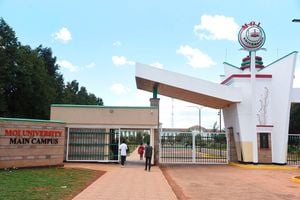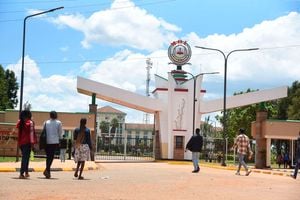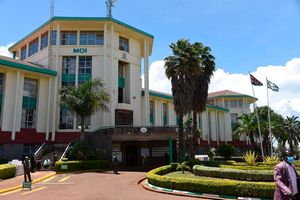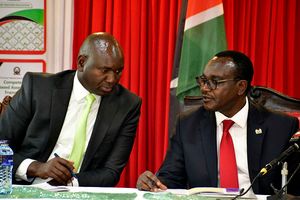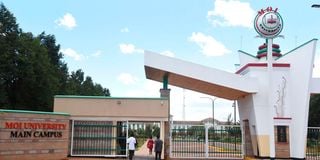
The entrance to Moi University's main campus in Kesses, Uasin Gishu County on February 8, 2024.
The troubles facing Moi University are far from over after the teaching and non-teaching staff accused the institution's management of flouting the return-to-work formula reached late last year.
This follows delayed payment of staff salaries, even after President William Ruto promised to set up a committee to review problems facing the institution.
“We fail to understand why Moi University is the only institution that is yet to honour the return-to-work formula and the 2021-2025 Collective Bargaining Agreement,” said Nyabuta Ojuki, Universities Academic Staff Union (Uasu) Moi University Chapter Secretary.
“The management needs to come out clean and disclose if they have received the funds and why it is yet to implement its bargain,” added Mr Ojuki.
In the deal, the union secured Sh7.7 billion under the 2021/2027 CBA to be implemented in two phases of Sh4.3 billion and Sh5.2 billion in the 2025/2026 and 2027/2027 financial years.
“The December salary factored in arrears for October and November, which other public universities and constituent campuses have paid their staff except Moi University, which amounts to flouting the return to work formula,” said Mr Ojuki.
He petitioned the government to find out the root cause of the crisis facing the university and put in place a long-lasting solution to the problem.
President Ruto has promised to constitute a committee to evaluate the scale of challenges facing the university and recommend solutions.
He disclosed plans to overhaul the management and allocate adequate resources to save the financially troubled institution of higher learning.
“We will put in place an efficient management team and allocate sufficient resources so that Moi University can thrive like other public universities,” said President Ruto on Friday during a tour of his home turf of Uasin Gishu County.
Sh2.6 billion
Under the return to work agreement signed in November and witnessed by Cabinet Secretary for Education Julius Ogamba, and Principal Secretary for Higher Education and Research Dr Beatrice Inyangala, the workers secured Sh2.6 billion in cash and assets with the immediate release of Sh500 million.
The University management is to surrender assets –land in Kitale, Nairobi, and Mombasa worth Sh2.1 billion which will be transferred to the pension schemes of both Uasu and Kenya University Staff Union.
In the 2025/2026 financial year, the union will receive Sh1.25 billion which will be used to offset the 20127/2017 Collective Bargaining Agreement (CBA) salary arrears.
An additional Sh3.3 billion will be released in the 2026/2027 financial year to settle bank loans and any arrears in the pension scheme.
The final payment of Sh1.75 billion will be factored in the 2027/2028 financial year and will be utilised to settle any pending payments.
According to the union officials, the Sh500 million has been set aside to settle the workers' immediate financial needs as they prepare to resume work.
Some Sh100 million was set aside to offset bank loans, Sh30 million for benevolent funds, Sh40 million for welfare, and Sh30 million for the Group Life Insurance Scheme.
Another Sh50 million was allocated for union dues and Sh100 million as a refund for bank loans paid by the workers.
Among financial irregularities under probe at the university include failure to remit Sh4 billion in payroll deductions, defaulted Sh3 billion loan owed to Rivatex East Africa Limited, and accumulated Sh1.1 billion in unpaid bills as of June 2020.
The declining student enrolment from 50,000 in 2015 to 27,000 in 2021 and about 20,000 in 2023, closure of non-viable campuses, reduced exchequer funding due to implementation of differentiated Unit Cost in computing the recurrent capitation and rising cost of personnel enrolment due to National Collective Bargaining Agreements that have not been fully funded are other factors contributing to miseries facing the institution.

